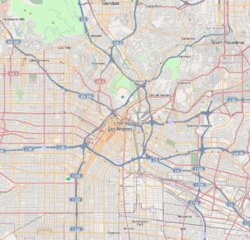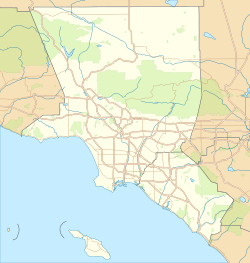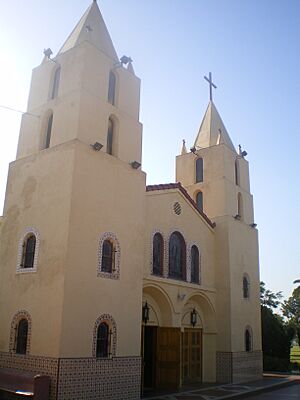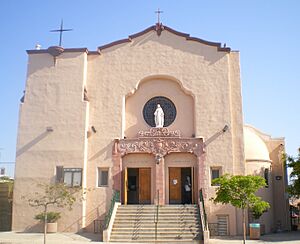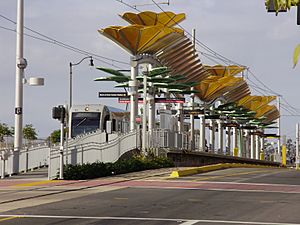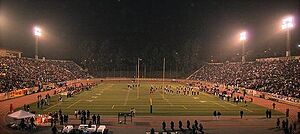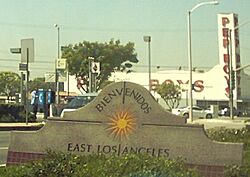East Los Angeles, California facts for kids
Quick facts for kids
East Los Angeles, California
|
|
|---|---|
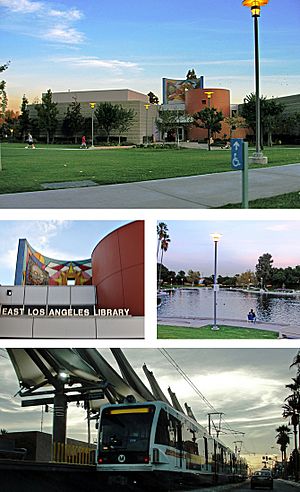
Images, from top and left to right: East LA Public Library, Civic Center Park, Atlantic E Line Station
|
|
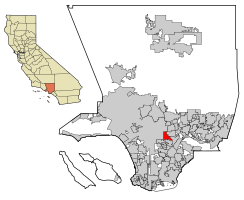
Location of East Los Angeles in Los Angeles County, California
|
|
| Country | |
| State | |
| County | Los Angeles |
| Area | |
| • Total | 7.46 sq mi (19.31 km2) |
| • Land | 7.45 sq mi (19.30 km2) |
| • Water | 0.00 sq mi (0.01 km2) 0.06% |
| Elevation | 200 ft (61 m) |
| Population
(2020)
|
|
| • Total | 118,786 |
| • Density | 15,938.01/sq mi (6,153.58/km2) |
| Time zone | UTC-8 (PST) |
| • Summer (DST) | UTC-7 (PDT) |
| ZIP code |
90022, 90063
|
| Area code(s) | 213 and 323 |
| FIPS code | 06-20802 |
| GNIS feature ID | 1660583 |
East Los Angeles, also known as East L.A., is a community in Los Angeles County, California, United States. It is not an official city but is a "census-designated place" (CDP). This means it's an area grouped for counting people by the government.
In 2020, about 118,786 people lived in East Los Angeles. This community has a very high percentage of Hispanic/Latino people, making up over 95% of its population. This is one of the highest percentages in the United States outside of Puerto Rico.
Contents
History of East Los Angeles
How East L.A. Got Its Name
The area we know as East Los Angeles today wasn't always called that. Back in 1873, a neighborhood northeast of downtown Los Angeles was first named East Los Angeles. This area is now called Lincoln Heights. In 1917, the people living there voted to change its name.
Later, other areas like Belvedere Gardens and Belvedere Heights, which were unincorporated county areas, started to be called East Los Angeles. By the 1930s, maps began to use "East Los Angeles" for the Belvedere area.
The Belvedere Area
In 1887, the first building for Occidental College was built on Rowan Street in this area. It was later destroyed by fire.
In 1905, a company called Janss Investment Company started developing land in what was then called "Boyle Heights." This large area, about 170 acres, was first named "Hazard's Eastside Extension." It was later called Highland Villa and then Belvedere Heights. This area included parts of what is now City Terrace.
By the early 1920s, many workers needed homes close to the growing factories. The Belvedere area was mostly undeveloped or used for farming and oil. In 1921, Janss bought more land south of Belvedere Heights, near what is now Whittier Boulevard. They divided this land into housing lots and called it Belvedere Gardens.
East Los Angeles was able to stay an unincorporated area (not part of a city) for a long time. This was partly because a private water company was formed in 1926. This meant the area didn't have to join the City of Los Angeles to get water. For many years, not being a city meant lower property taxes for the people living there.
East Los Angeles: A New Identity
In 1932, local business leaders decided to officially name Belvedere and nearby areas "East Los Angeles." However, in 1937, some signs still said "Belvedere Gardens." Business leaders removed these signs in a special ceremony, and the area was officially renamed East Los Angeles. At that time, it had about 75,000 residents and was known as the largest unincorporated community in the world.
East Los Angeles played a big role in the Chicano Movement. This was a time when Mexican Americans fought for their rights. Important events included the East L.A. Walkouts in 1968, where students protested for better education. The National Chicano Moratorium also took place here, a large protest against the Vietnam War.
Over the years, residents have tried to make East Los Angeles an official city, but it remains an unincorporated community.
Geography and Climate
Where is East L.A.?
East Los Angeles is located just east of the Boyle Heights area of Los Angeles. It's south of El Sereno and north of the city of Commerce. To its west are the cities of Monterey Park and Montebello. The northern part of East L.A. includes the unincorporated area known as City Terrace.
Weather in East L.A.
East Los Angeles has a very warm hot-summer Mediterranean climate. This means it has hot, dry summers and mild, wet winters.
| Climate data for East Los Angeles, California (1981–2010 normals) | |||||||||||||
|---|---|---|---|---|---|---|---|---|---|---|---|---|---|
| Month | Jan | Feb | Mar | Apr | May | Jun | Jul | Aug | Sep | Oct | Nov | Dec | Year |
| Mean daily maximum °F (°C) | 73 (23) |
74 (23) |
76 (24) |
80 (27) |
83 (28) |
85 (29) |
90 (32) |
92 (33) |
91 (33) |
83 (28) |
77 (25) |
73 (23) |
81 (27) |
| Mean daily minimum °F (°C) | 48 (9) |
48 (9) |
51 (11) |
53 (12) |
57 (14) |
61 (16) |
65 (18) |
65 (18) |
63 (17) |
58 (14) |
52 (11) |
47 (8) |
56 (13) |
| Average precipitation inches (mm) | 3.78 (96) |
3.53 (90) |
2.66 (68) |
0.93 (24) |
0.33 (8.4) |
0.06 (1.5) |
0.01 (0.25) |
0.03 (0.76) |
0.18 (4.6) |
0.30 (7.6) |
1.21 (31) |
2.43 (62) |
16.43 (417) |
People of East Los Angeles
| Historical population | |||
|---|---|---|---|
| Census | Pop. | %± | |
| 1960 | 104,270 | — | |
| 1970 | 104,881 | 0.6% | |
| 1980 | 110,017 | 4.9% | |
| 1990 | 126,379 | 14.9% | |
| 2000 | 124,283 | −1.7% | |
| 2010 | 126,496 | 1.8% | |
| 2020 | 118,786 | −6.1% | |
| U.S. Decennial Census 1850–1870 1880-1890 1900 1910 1920 1930 1940 1950 1960 1970 1980 1990 2000 2010 |
|||
East Los Angeles is known for its large Mexican population. Many people here have roots in Mexico and El Salvador.
Population in 2010
In 2010, East Los Angeles had 126,496 residents. About 97.1% of the people were Hispanic or Latino. Most people lived in homes, with an average of about four people per household.
About 31.5% of the population was under 18 years old. The median age was 29.1 years, meaning half the people were younger and half were older than that age. The median household income was $37,982. About 26.9% of the population lived below the federal poverty line.
Population in 2000
In 2000, there were 124,283 people living in East Los Angeles. About 96.8% of the population was Hispanic or Latino. Spanish was the main language spoken at home for 87.30% of residents, while English was spoken by 12.65%.
The median income for a household was $28,544. About 27.2% of the population lived below the poverty line. East Los Angeles has a very large Latino population, including people from Mexico, El Salvador, Guatemala, Honduras, and Nicaragua.
Homelessness in East L.A.
The Los Angeles Homeless Services Authority counts the number of people experiencing homelessness. In 2022, they counted 617 people experiencing homelessness in East Los Angeles.
| Homeless population | ||
|---|---|---|
| Year | Pop. | ±% |
| 2016 | 231 | — |
| 2017 | 461 | +99.6% |
| 2018 | 343 | −25.6% |
| 2019 | 604 | +76.1% |
| 2020 | 550 | −8.9% |
| 2022 | 617 | +12.2% |
| Source: Greater Los Angeles Homeless Count Los Angeles Homeless Services Authority |
||
Getting Around East L.A.
Train and Bus Services
East Los Angeles has light rail service provided by the E Line. This train line opened in 2009. Long ago, in the early 1900s, streetcars also served East L.A., traveling along what is now Whittier Boulevard. This street became a main road for moving goods and people.
The Los Angeles County Metropolitan Transportation Authority (Metro) offers bus service throughout the Los Angeles area from East L.A. There's also a local shuttle service called El Sol.
Parking and Bikes
Near the Metro Atlantic station, there's a large parking structure for cars. Many E Line stations also have places to park bicycles, like bike racks and lockers.
Learning in East L.A.
Public Schools
East Los Angeles has public schools managed by two different school districts: Los Angeles Unified School District (LAUSD) and Montebello Unified School District.
Many elementary schools are in East Los Angeles, including Belvedere, Brooklyn Avenue, City Terrace, and Rowan Avenue. Some schools, like Humphreys Avenue Elementary, are Magnet Schools focusing on STEM (Science, Technology, Engineering, Arts, and Math).
Middle schools include Belvedere and Griffith STEAM Magnet. There was a petition to change the name of Griffith Middle School because of its connection to D. W. Griffith, a filmmaker whose 1915 movie The Birth of a Nation was controversial.
James A. Garfield High School is the main public high school in East Los Angeles. It opened in 1925. Garfield High School is famous for the "East LA Classic" football game against Theodore Roosevelt High School, which draws many fans. Ramona Opportunity High School is an alternative high school for girls. Esteban Torres High School opened in 2010.
Charter Schools
East Los Angeles also has several Knowledge Is Power Program (KIPP) charter schools. These are free, public schools that prepare students for college. Examples include Raíces Academy and Sol Academy. Other charter schools like Ánimo Ellen Ochoa Charter Middle School and Esperanza College Prep High School also serve the community.
Private Schools
The Roman Catholic Archdiocese of Los Angeles runs several Catholic private schools in East Los Angeles. These include Our Lady of Lourdes School, St. Alphonsus School, and Our Lady of Guadalupe School.
Libraries in East L.A.
East Los Angeles Library
The County of Los Angeles Public Library operates the East Los Angeles Library. It first opened in 1923 as a small collection of books in a store. The current building, which opened in 2004, is very large and has areas for adults and children. It also has a special Chicano Resource Center. The library's design includes themes and art inspired by the Mayan people, as requested by local residents.
Anthony Quinn Library
The Anthony Quinn Library, originally called the Belvedere Library, opened in 1914. It was renamed in 1982 after the famous actor Anthony Quinn, whose childhood home was on the site of the library. In 1987, Quinn donated many of his movie scripts and personal papers to the library.
Other Libraries
Other libraries in the area include the El Camino Real Library and the City Terrace Library, both operated by the county. These libraries offer various services and resources to the community.
Cool Places to See
Our Lady of Solitude Church
Our Lady of Solitude, also known as Soledad Church, opened on Christmas Day in 1925. It's built in the Spanish Colonial Revival style. Since 1931, the church has held an outdoor procession each December to honor Our Lady of Guadalupe. This is the oldest religious procession in Los Angeles.
In the 1960s, labor leader Cesar Chavez and the United Farm Workers often met at this church. The street in front of the church is now named Cesar Chavez Avenue in his honor.
The Golden Gate Theater
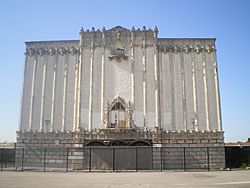
The former Golden Gate Theater is a beautiful old movie palace built in 1927. It's designed in a special Spanish Baroque Revival style called Churrigueresque. It was the first building in East Los Angeles to be listed on the National Register of Historic Places in 1982.
Maravilla Handball Court
The Maravilla handball court was built by residents in 1928. It's the oldest remaining handball court in the Los Angeles area. It's a special place where people still play bola basca, also known as Basque pelota. In 2012, the court was added to the California Register of Historical Resources.
Veterans Memorial
At Atlantic Park, there's an obelisk-shaped monument dedicated on May 30, 1930. A plaque on it reads, "In memory of heroes of all American wars," honoring those who served.
Latino Walk of Fame
The Latino Walk of Fame is similar to the famous one in Hollywood. It honors Latino celebrities and leaders who have made important contributions. It was started in 1997 on Whittier Boulevard, the heart of East L.A.
El Pino (The Pine Tree)
El Pino (The Pine Tree) is a very large bunya pine tree. It stands on a small hill overlooking East Los Angeles. Many people in the community see this tree as a symbol of their area's diverse background and a sign of community strength.
Parks and Fun Places
Los Angeles County manages the parks and recreation areas in East Los Angeles.
Belvedere Community Regional Park
Belvedere Community Regional Park is a large park built in 1942. It has baseball fields, picnic areas, basketball courts, a playground, and a community center. There's also a skate park, soccer field, swimming pool, and tennis courts. A pond in the park, known as "El Parque de los Patos" (The duck park), is stocked with fish for fishing. In 1970, this park was the starting point for the Chicano Moratorium, a big protest.
Other Parks
- Atlantic Avenue Park has a children's play area, picnic spots, and a swimming pool. It also has a rose garden cared for by volunteers.
- Eugene A. Obregon Park is named after Eugene A. Obregon, a war hero. It has basketball courts, a computer center, a gym, a swimming pool, and walking paths.
- Salazar Park is another important park in East Los Angeles. It has baseball fields, basketball courts, a computer center, a gym, and a swimming pool. A plaque was placed here in 2014 to honor Ruben Salazar, a journalist who was killed during the Chicano Moratorium.
- Saybrook Park offers outdoor basketball courts, a ball field, playgrounds, and a community building.
- City Terrace County Park was developed in 1933. It has a basketball court, playground, gym, swimming pool, and tennis courts.
Eastside Eddie Heredia Boxing Club
The Eastside Eddie Heredia Boxing Club is located in a former fire station. It's named after Eddie Heredia, a young boxer who passed away. This club has helped train boxers, including one who joined the United States Olympic Boxing Team for the 2008 Beijing Olympics.
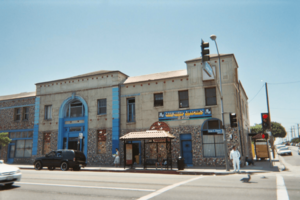
Famous People from East L.A.
Many notable people have come from East Los Angeles, including:
- Oscar De La Hoya, a world boxing champion and Olympic gold medalist.
- Jaime Escalante, a famous educator whose story was told in the movie Stand and Deliver.
- Anthony Quinn, a well-known actor.
- Edward James Olmos, an actor, producer, and director.
- Antonio Villaraigosa, who became the 41st mayor of Los Angeles.
- Carlos Montes, a Chicano activist and co-founder of the Brown Berets.
- Lucille Roybal-Allard, a U.S. Representative.
See also
 In Spanish: Este de Los Ángeles para niños
In Spanish: Este de Los Ángeles para niños


